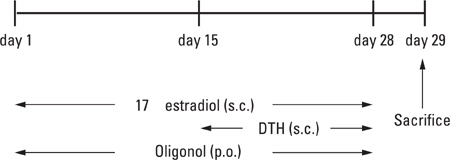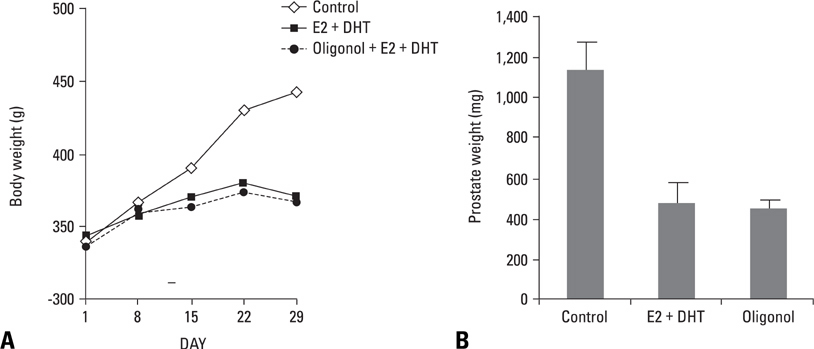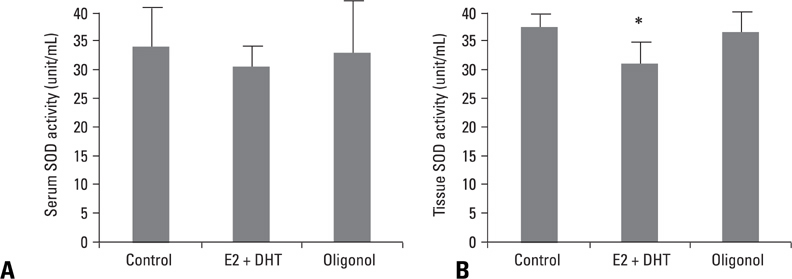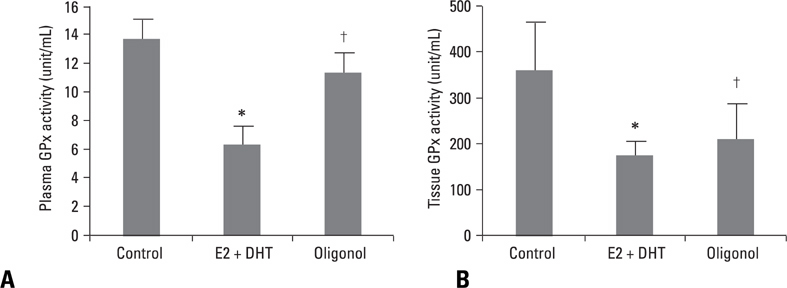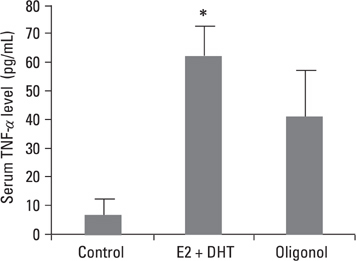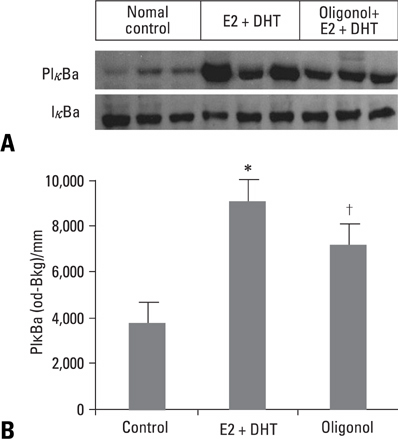Yonsei Med J.
2009 Jun;50(3):391-398. 10.3349/ymj.2009.50.3.391.
Preventive Effects of Oligomerized Polyphenol on Estradiol-Induced Prostatitis in Rats
- Affiliations
-
- 1Department of Urology, Urological Science Institute, Brain Korea 21 Project for Medical Science, Yonsei University College of Medicine, Seoul, Korea. sjhong346@yuhs.ac
- KMID: 1758568
- DOI: http://doi.org/10.3349/ymj.2009.50.3.391
Abstract
-
PURPOSE: Chronic prostatitis/chronic pelvic pain syndrome (CP/CPPS, NIH category III) accounts for 90-95% of prostatitis cases. However, standard treatment has not yet been established. It is known that polyphenols have an inhibitory effect on inflammation by their antioxidative capacity, and oligonol, a polyphenol derivative, has much higher bioavailability and bioactivity than common polyphenols. We investigated the anti-inflammatory effects and mechanisms of oligonol in estradiol-induced prostatitis rat models.
MATERIALS AND METHODS
Prostatitis was induced by 17 beta-estradiol (E2) and dihydrotestosterone (DHT) in Wistar male rats (n = 20). Ten rats were placed in the oligonol-treated group and 10 in the E2 + DHT-treated group. The other 10 rats were also included as normal control group. Oligonol (60 mg/kg/day) was administered via gavage tube for 4 weeks. Superoxide dismutase (SOD), glutathione peroxidase (GPx), and tumor necrosis factor-alpha (TNF-alpha) were quantified, and phosphorylation of IkappaBa and histological changes were also evaluated in prostatic tissue.
RESULTS
The SOD and GPx activity showed tendencies to increase in the oligonol-treated group compared to the normal control group. TNF-alpha expression was slightly reduced in the oligonol-treated group. Western blotting demonstrated that phosphorylation of IkappaBa in the oligonol-treated group was significantly lower than in the normal control group. The E2 + DHT-treated group revealed severe atrophy of acinar epithelial cells and infiltration of leukocytes and lymphocytes in the prostate, however, the oligonol-treated group showed overall reduction in inflammatory features.
CONCLUSION
This study demonstrates that oligonol improves estradiol-induced non-bacterial prostatitis by regulating phosphorylation of IkappaBa. These findings suggest that oligonol has a beneficial effect on prevention and treatment of CP/CPPS.
MeSH Terms
-
Animals
Blotting, Western
Body Weight/drug effects
Estradiol/*adverse effects
Flavonoids/*therapeutic use
Immunoassay
Male
Phenols/*therapeutic use
Prostate/drug effects/pathology
Prostatitis/*chemically induced/metabolism/*prevention & control
Rats
Rats, Wistar
Superoxide Dismutase/metabolism
Tumor Necrosis Factor-alpha/metabolism
Figure
Cited by 1 articles
-
Anti-Inflammatory Effect of Phlorotannin on Chronic Nonbacterial Prostatitis in a Rat Model
Yun Seok Jung, Yong-Hyun Cho, Chang Hee Han
Korean J Urogenit Tract Infect Inflamm. 2014;9(2):86-92. doi: 10.14777/kjutii.2014.9.2.86.
Reference
-
1. Fowler JE Jr. Gillenwater JA, Grayhack JT, Howard SS, Duckett JW, editors. Prostatitis. Adult and pediatric urology. 1991. St. Louis: Mosby-Year Book;1395–1423.2. Scalbert A, Johnson IT, Saltmarsh M. Polyphenols: antioxidants and beyond. Am J Clin Nutr. 2005. 81:215S–217S.
Article3. Rahman I, Biswas SK, Kirkham PA. Regulation of inflammation and redox signaling by dietary polyphenols. Biochem Pharmacol. 2006. 72:1439–1452.
Article4. Kim IB, Kim DY, Lee SJ, Sun MJ, Lee MS, Li H, et al. Inhibition of IL-8 production by green tea polyphenols in human nasal fibroblasts and a549 epithelial cells. Biol Pharm Bull. 2006. 29:1120–1125.
Article5. Shoskes DA, Zeitlin SI, Shahed A, Rajfer J. Quercetin in men with category III chronic prostatitis: a preliminary prospective, double-blind, placebo-controlled trial. Urology. 1999. 54:960–963.
Article6. Fujii H, Sun B, Nishioka H, Hirose A, Aruoma OI. Evaluation of the safety and toxicity of the oligomerized polyphenol Oligonol. Food Chem Toxicol. 2007. 45:378–387.
Article7. Naslund MJ, Strandberg JD, Coffey DS. The role of androgens and estrogens in the pathogenesis of experimental nonbacterial prostatitis. J Urol. 1988. 140:1049–1053.
Article8. Seethalakshmi L, Bala RS, Malhotra RK, Austin-Ritchie T, Miller-Graziano C, Menon M, et al. 17 beta-estradiol induced prostatitis in the rat is an autoimmune disease. J Urol. 1996. 156:1838–1842.
Article9. Lundgren R, Holmquist B, Hesselvik M, Müntzing J. Treatment of prostatitis in the rat. Prostate. 1984. 5:277–284.
Article10. Müntzing J, Sufrin G, Murphy GP. Prostatitis in the rat. Scand J Urol Nephrol. 1979. 13:17–22.
Article11. Wheeler DS, Catravas JD, Odoms K, Denenberg A, Malhotra V, Wong HR. Epigallocatechin-3-gallate, a green tea-derived polyphenol, inhibits IL-1 beta-dependent proinflammatory signal transduction in cultured respiratory epithelial cells. J Nutr. 2004. 134:1039–1044.
Article12. Birrell MA, McCluskie K, Wong S, Donnelly LE, Barnes PJ, Belvisi MG. Resveratrol, an extract of red wine, inhibits lipopolysaccharide induced airway neutrophilia and inflammatory mediators through an NF-kappaB-independent mechanism. FASEB J. 2005. 19:840–841.13. Manna SK, Mukhopadhyay A, Aggarwal BB. Resveratrol suppresses TNF-induced activation of nuclear transcription factors NF-kappa B, activator protein-1, and apoptosis: potential role of reactive oxygen intermediates and lipid peroxidation. J Immunol. 2000. 164:6509–6519.
Article14. Donnelly LE, Newton R, Kennedy GE, Fenwick PS, Leung RH, Ito K, et al. Anti-inflammatory effects of resveratrol in lung epithelial cells: molecular mechanisms. Am J Physiol Lung Cell Mol Physiol. 2004. 287:L774–L783.
Article15. Robinette CL. Sex-hormone-induced inflammation and fibromuscular proliferation in the rat lateral prostate. Prostate. 1988. 12:271–286.
Article16. Bernoulli J, Yatkin E, Konkol Y, Talvitie EM, Santti R, Streng T. Prostatic inflammation and obstructive voiding in the adult Noble rat: impact of the testosterone to estradiol ratio in serum. Prostate. 2008. 68:1296–1306.
Article17. Irani J, Levillain P, Goujon JM, Bon D, Doré B, Aubert J. Inflammation in benign prostatic hyperplasia: correlation with prostate specific antigen value. J Urol. 1997. 157:1301–1303.
Article18. Shull JD, Gorski J. Regulation of prolactin gene transcription in vivo: interactions between estrogen, pimozide, and alphaergocryptine. Mol Pharmacol. 1990. 37:215–221.19. Tangbanluekal L, Robinette CL. Prolactin mediates estradiol-induced inflammation in the lateral prostate of Wistar rats. Endocrinology. 1993. 132:2407–2416.
Article20. Wilson MJ, Woodson M, Wiehr C, Reddy A, Sinha AA. Matrix metalloproteinases in the pathogenesis of estradiol-induced nonbacterial prostatitis in the lateral prostate lobe of the Wistar rat. Exp Mol Pathol. 2004. 77:7–17.
Article21. Domingue GJ Sr, Hellstrom WJ. Prostatitis. Clin Microbiol Rev. 1998. 11:604–613. discussion 213-6.
Article22. Arakawa S, Matsui T, Gohji K, Okada H, Kamidono S. Prostatitis--the Japanese viewpoint. Int J Antimicrob Agents. 1999. 11:201–203. discussion 213-6.
Article23. Donovan DA, Nicholas PK. Prostatitis: diagnosis and treatment in primary care. Nurse Pract. 1997. 22:144–146. 149–156.24. Fujii H, Yokozawa T, Kim YA, Tohda C, Nonaka G. Protective effect of grape seed polyphenols against high glucose-induced oxidative stress. Biosci Biotechnol Biochem. 2006. 70:2104–2111.
Article25. Li MH, Jang JH, Sun B, Surh YJ. Protective effects of oligomers of grape seed polyphenols against beta-amyloid-induced oxidative cell death. Ann N Y Acad Sci. 2004. 1030:317–329.
Article26. Orsilles MA, Depiante-Depaoli M. Oxidative stress-related parameters in prostate of rats with experimental autoimmune prostatitis. Prostate. 1998. 34:270–274.
Article27. Lou JG, Dong J, Zheng YC, Zhang SM, Xiao WQ, Zhou JF. Increased oxidative stress and damage in patients with chronic bacterial prostatitis. Biomed Environ Sci. 2006. 19:481–486.28. Pasqualotto FF, Sharma RK, Potts JM, Nelson DR, Thomas AJ, Agarwal A. Seminal oxidative stress in patients with chronic prostatitis. Urology. 2000. 55:881–885.
Article29. Sharma RK, Pasqualotto FF, Nelson DR, Thomas AJ Jr, Agarwal A. The reactive oxygen species-total antioxidant capacity score is a new measure of oxidative stress to predict male infertility. Hum Reprod. 1999. 14:2801–2807.
Article30. Rahman I, Gilmour PS, Jimenez LA, MacNee W. Oxidative stress and TNF-alpha induce histone acetylation and NF-kappaB/AP-1 activation in alveolar epithelial cells: potential mechanism in gene transcription in lung inflammation. Mol Cell Biochem. 2002. 234-235:239–248.
- Full Text Links
- Actions
-
Cited
- CITED
-
- Close
- Share
- Similar articles
-
- The Anti-Inflammatory Effects of a New Herbal Formula (WSY-1075) in a Nonbacterial Prostatitis Rat Model
- BCG Induced Granuloma tous Prostatitis: A case report
- Preventive Effect on Inflammation and Anti-Inflammatory and Anti-Microbial Effects of Garlic Extract in a Rat Model of Chronic Bacterial Prostatitis
- The Effect of Estradiol and Progesterone on the Concentration of Estradiol Receptor in Uterine Tissue During the Early Pregnancy of Rats
- Anti-Inflammatory Effect of Phlorotannin on Chronic Nonbacterial Prostatitis in a Rat Model

